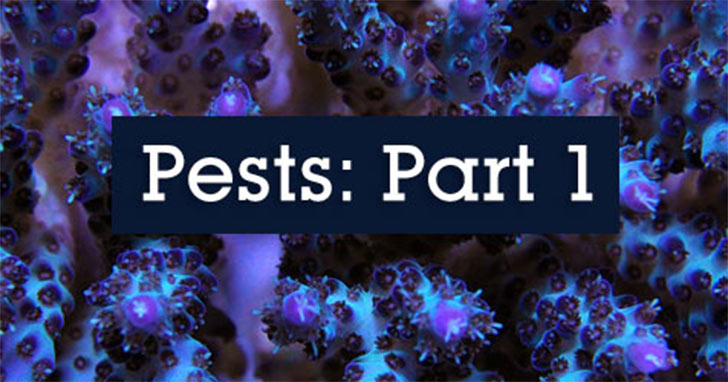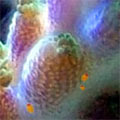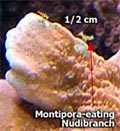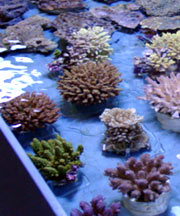
Over the past decade, the marine aquarium hobby has enjoyed advancements in both technology and information regarding the captive care of live coral. As a result, many organizations and hobbyists have begun fragmenting and producing corals that are offered for sale in the marketplace, and traded among hobbyists.

These corals, commonly referred to as "Frags," include a large number of SPS (Small Polyp Stony Corals), LPS (Large Polyp Stony Corals), Soft Corals, Zoanthus Polyps and Mushrooms. These species normally adapt very well to a captive environment, but unfortunately numerous pests and parasites have also reared their presence in home aquariums across the country. With the practice of swapping coral frags among hobbyists, club members, and the aquaculture facilities themselves, the presence of these pests in the U.S. is increasing at an alarming rate.
Here's what every hobbyist needs to know about the identification and prevention of common "frag" pests that are finding their way into home reef aquariums.
Acropora Red Bugs
 Identification
Identification
One of the most recent "pests" that has now become prevalent is a very small crustacean that looks like a mite and appears to prefer most species of Acropora corals. This crustacean is yellow in color with a red dot, approximately 1/2 mm in length, and is very difficult to see without a magnifying glass. It has been theorized that red bugs are either a parasitic form of copepod or micro-amphipod, though very little research has been done and their true identification is not complete at this time.
 Symptoms & Signs
Symptoms & Signs
It has been speculated that the crustacean feeds off of the slime and waste products produced by the Acroporas. If you have an established colony of Acropora sp. that begins losing coloration and stops showing normal polyp extension, take a closer look at the tissue of the coral for any small yellowish/red specks. It is oftentimes easiest to distinguish these pests on the shadowed underside of a branch. An infected colony of Acropora will typically show poor or no polyp extension, and will slowly lose coloration over time. As a result of this infestation, it has been found that the growth rate of the colony is seriously affected, and may even result in death to the coral itself.
It is not clear why these bugs prefer certain species of Acropora over others, nor is it clear why they are not found on other SPS corals such as Montipora, Pocillopora, or Seriatopora.
Treatment
Several methods of treatment - from introducing natural predators to medications - have been tested with various levels of success.

- Introduce Dragonface Pipefish (Corythoichthys haematopterus) to the quarantine or display aquarium. Once the fish are settled in and adjusted to the aquarium conditions, the small pipefish will anchor themselves on the branches of Acropora and begin to feed on tiny crustaceans as well as red bugs.
- Dip the Acropora into a concentrated iodine and aquarium water mixture for approximately 15 minutes using a clean plastic container. Lugol's solution is the preferred iodine base for this procedure, along with other commercially available coral dips, such as Reef Dip by SeaChem.
- The last method, developed by Dustin Dorton at ORA™, involves treating the aquarium or quarantine aquarium with Milbemycin oxime. This chemical is the active ingredient in Interceptor, a de-worming medication for dogs only available by prescription from a veterinarian. This medication has been found to directly attack crustaceans, and is the most invasive and risky treatment mentioned thus far because it does not discriminate between pests and other inhabitants like shrimp, amphipods, copepods, and crabs. Since this treatment may cause all crustaceans in your system to perish, it is important to either remove and treat the infected colonies in a separate aquarium, or to remove the crustaceans that you wish to save to a different holding aquarium. Exact guidelines for the dosages and treatment regimen are still in the testing phase, yielding positive results, but the long-term ramifications of this new treatment are still not known.
 Coral-eating Nudibranch
Coral-eating Nudibranch
Identification
Several species of nudibranch which feed upon Soft Corals like Sarcophyton sp. Leather corals, Xenia sp., Zoanthus sp., and Palythoa sp. polyps have made their way into the industry over the years. Most of the soft coral-eating nudibranchs can reach a size of 2 cm when full grown, and are best seen after the lights have been off on the aquarium for several hours. They often mimic the appearance of the coral they are preying upon, making them difficult to spot. Soft coral-eating nudibranchs will slowly consume these corals causing bare spots or discoloration on some or all of the corals tissue.
 A more recent nudibranch pest that affects SPS coral aquariums has recently become prevalent, and prefers to consume corals of the genus Montipora and Anacropora. These nudibranch are very small, attaining a maximum size of only up to half of a centimeter, are pale white to tan in color, and have many branch-like appendages along their back. They are very damaging pests in a reef aquarium that can multiply and consume corals in a very short period of time.
A more recent nudibranch pest that affects SPS coral aquariums has recently become prevalent, and prefers to consume corals of the genus Montipora and Anacropora. These nudibranch are very small, attaining a maximum size of only up to half of a centimeter, are pale white to tan in color, and have many branch-like appendages along their back. They are very damaging pests in a reef aquarium that can multiply and consume corals in a very short period of time.
Symptoms & Signs
Corals that become infected with these pests will begin to show white spots where the nudibranchs have eaten away the tissue of the coral. The most vulnerable seem to be Montipora capricornis, also known as vase corals, as well as Montipora digitata, the branching form. Many times the nudibranch will begin feeding on the underside of the coral, and it will not become apparent to the hobbyist that the coral is being damaged until it can be seen in plain view on the top of the colony.
Treatment
Controlling outbreaks of these pests is difficult, and several different techniques are being experimented with. Removal of these pests is often performed manually with tweezers.

- Natural predators of the nudibranch are butterflyfish of the Chaetodon genus,
wrasse of the genus Thalassoma and Coris. Two species of Butterflyfish fish in particular that have been noted as being efficient predators are: Chaetodon semilarvatus, the Red Sea Butterfly and Chaetodon auriga, the Thread Fin Butterfly. Be advised that these fish will also consume worms, such as feather dusters and those that inhabit live sand beds in the reef aquarium.
- Chemical techniques have been also used, yielding varying results. Iodine dips using a concentrated Lugol's and aquarium water mixture will kill the nudibranch, but seems to have a limited success rate on the eggs. Another chemical called Levamisol has been used with a good deal of success. However, the development of this treatment along with specific dosages and treatment lengths, are in preliminary stages, and this medication is only available with a prescription from a licensed veterinarian.
The problem that exists with chemical dips is that it will only kill the nudibranchs that are on the colony and the rock that the coral is attached to when treated. This nudibranch has been found to lay eggs within the rockwork of the aquarium, as well as on other coral colonies. Therefore, just treating the colony and its associated rock will not solve the problem. One answer to this is to remove all colonies of Montipora and Anacropora to a separate containment system for a few months, and to repeatedly treat the corals and their associated rock with an iodine dip. This will ensure that the nudibranch within the display aquarium are eradicated due to starvation. Also, you will be able to monitor the health of the infected colonies with greater ease in the smaller system.
How to Reduce the Chances of Infecting Your Aquarium
 The best remedy to these pests is by not introducing them into your aquarium, following proper quarantine procedures for all aquatic inhabitants, including corals and invertebrates. Only purchase specimens from a reputable vendor that takes precautions against these pests. Your vendor should practice proper husbandry and quarantine procedures, keep a close eye on their holding systems, and should perform the appropriate treatments if the need arises. Ask your vendor what protocols they employ in keeping their system free of pests and pathogens.
The best remedy to these pests is by not introducing them into your aquarium, following proper quarantine procedures for all aquatic inhabitants, including corals and invertebrates. Only purchase specimens from a reputable vendor that takes precautions against these pests. Your vendor should practice proper husbandry and quarantine procedures, keep a close eye on their holding systems, and should perform the appropriate treatments if the need arises. Ask your vendor what protocols they employ in keeping their system free of pests and pathogens.
Also when trading frags with a fellow hobbyist, do not take his word that his system is free and clean of pests. We cannot stress enough the importance of quarantining all new specimens until you are sure that the colony is free of any unwanted organisms and have adjusted to their new environment. This is also a great time to slowly acclimate your new arrivals to both the water conditions and the type of lighting that is used on your main system.
A reef aquarium offers us a unique ability to enjoy some of nature's most beautiful creatures in the comfort of our homes. Although mostly a relaxing hobby, there are times that it can become frustrating. The pests mentioned in this article can take the joy out of a reef aquarium making it a real burden. It is important to take preventive measures whenever adding new colonies to your display aquarium, as well as acting immediately if pests or parasites are ever noticed.
| Part 1 |
Part 2 |
|